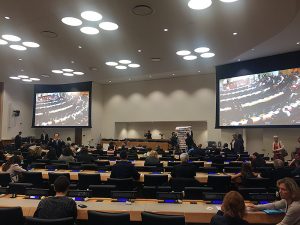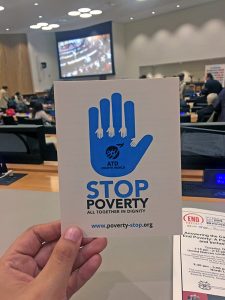What Does Poverty Look Like?
By Viviana Garcia-Blanco, Dominican Volunteer
There are certain people who enter the direct service sector with an idea of what poverty is and what it looks like. Coming from the world of academia, these people spend a majority of their time reading and researching this topic, never really acknowledging that they only engaged with this issue on a superficial level. When they finally do enter the field, they are faced with enormous systemic problems that they are unprepared to address and tackle. Often times, these people are burned out and leave the sector or end up staying as another contributor to this problematic system. Academia does not prepare you for the harsh reality of just how deeply overwhelming and challenging poverty is on the regional and international level.
On October 17th the UN held an event for the International Day of the Eradication of Poverty. The event focused on three speakers who came from backgrounds of poverty, each of whom spoke about their individual life experiences. All of the speakers seemed to echo the same problem they were faced with time and time again: governments, social workers, and civil society, were not prepared to handle their cases in a fair unbiased manner. People living in poverty tend to be prejudged before all the facts are known about their case. They are constantly dehumanized in the media and are blamed for their own problems.
U.S. Poverty statistics gives us an interesting insight into who poverty affects the most. According to TalkPoverty.org, a project by the nonpartisan policy institute Center for American Progress, there are currently 40.6 million people living below the poverty line. Of this 40.6 million, African Americans make up 9.2 million, Hispanics make up 11.1 million, and Native Americans make up 700,000 people. Women and children made up 36.2 million and people with disabilities accounted for 4.1 million. (1) The pattern is clear; people of color, women and children, and people with disabilities are the most marginalized and oppressed in society. A number of factors play into this reality. According to the National Policy Center’s Policy Brief on The Colors of Poverty: Why Racial & Ethnic Disparities Persist, factors like anti-discrimination laws in employment, housing laws, and lack of access quality education, are some of the major contributors to poverty (2). It would seem that many of the systems that are in place tend to keep viable options limited for a significant portion of the population.
Here in the U.S. a popular saying within the middle and upper-class is “Pull yourself up by your bootstraps!” or in other words, don’t ask anyone for help, do it on your own. I can see how for some people this could be considered an innocent saying but for others, this kind of rhetoric plays a big part in the way society addresses poverty.
I am reminded of the Catholic Social Teaching model that reminds us of the core values the church and its members should live by. Of the 7 themes, the most important and relevant in my opinion are; fight racial/social/economic oppression on all levels, and stand in solidarity with those facing social injustices. These teachings help us strive toward the common good in society, as we often have to hold the state and other institutions accountable for these injustices. And as Catholics we should be reminded of these teachings every now and then.
If you see poverty as an individual choice and not as a systemic failure of society and government you are playing into this toxic narrative of blaming the victim. I ask the Dominican community to challenge not only the way they see poverty but to challenge those who do not acknowledge the complexity of this issue. It has never been a one-dimensional issue. Sexism, racism, and classism are all intersectional issues that cannot be eradicated separately. How can each of us at the local level make a difference in the lives of others? How can we live our lives living the Caritas et Veritas model?
Interested in knowing about the economic health of your state and congressional district? Talkpovery.org has created an interactive map that allows you to view these indicators. Check out the link below to learn more about your state and find other articles relating to combating poverty:
Want to watch the Answering the Call of October 17 to End Poverty: A Path Toward Peaceful and Inclusive Societies live event?
Click on the link below to watch:
http://www.atd-fourthworld.org/stop-poverty/
References
(1) https://talkpoverty.org/basics/
(2) http://www.npc.umich.edu/publications/policy_briefs/brief16/PolicyBrief16.pdf
Photos from Answering the Call of October 17 to End Poverty: A Path Toward Peaceful and Inclusive Societies. Photos taken by Viviana Garcia-Blanco



 Dominican Leadership Conference
Dominican Leadership Conference